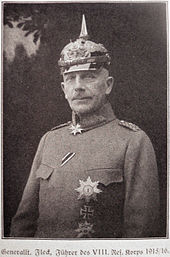VIII Reserve Corps (German Empire)
The VIII. Reserve Corps was a large unit of the army of the German Empire .
structure
The corps was subordinate to the 4th Army at the beginning of the war and was structured as follows:
-
15th Reserve Division
- 30th Reserve Infantry Brigade
- 32nd Reserve Infantry Brigade
- Reserve Uhlan Regiment No. 5
- Reserve Field Artillery Regiment No. 15
- 4th Company / Engineer Battalion No. 8
-
16th Reserve Division
- 29th Reserve Infantry Brigade
- 31st Reserve Infantry Brigade
- Heavy Reserve Cavalry Regiment No. 2
- Reserve Field Artillery Regiment No. 16
- 1st and 2nd Reserve Company / Engineer Battalion No. 8
- Feldgendamerietrupp VIII Reserve Corps
history
With the mobilization on August 2, 1914 at the outbreak of the First World War , the corps was set up.
In association with the 4th Army , it marched into France under the leadership of General Infantry Wilhelm von und zu Egloffstein and fought on the Western Front throughout the war . During the Battle of Neufchâteau on August 22nd and 23rd, 1914, the VIII. Reserve Corps from the 2nd meeting intervened in the fighting and removed the danger in the XVIII. Army Corps was hit by a French counterattack between Maissin and Bertrix . The 15th Reserve Division (Lieutenant General Eberhard von Kurowski ) reached Villance via Libin and carried out a counter-attack on Maissin. The 16th Reserve Division following behind (Lieutenant General Wilhelm Mootz ) stormed the heights west of Anloy before evening.
At the end of September 1914, the 3rd Army Corps was assigned to Colonel General Karl von Eine . Since the beginning of 1915 under the new commander General Paul Fleck - together with the VIII Army Corps ( Julius Riemann ), it bore the brunt of repelling the French mass storms in the winter battle in Champagne . In September 1915, during the autumn battle , the 16th Reserve Division was initially a reserve in the hinterland near Tahure, while the 15th Reserve Division (Major General Kurt von Ditfurth ) was immediately the focus of the French attacks between Ripont and Massiges.
The year 1916 was quieter and was given by defending against minor advances in the usual trench warfare. On September 7, 1916, General Wichura was appointed the new commanding general . In April 1917, at the beginning of the Battle of Arras , the VI was replaced. Reserve Corps as a Souchez group and the defense against English attacks. From the end of May to August 1917 the corps was then in Upper Alsace and then took part in the fighting at the Ailette with the 7th Army . The corps was assigned the 14th , 37th and 52nd divisions during the Battle of Malmaison in October 1917 , and the Laffaux corner was lost due to the French attacks .
On April 6, 1918, as part of the spring offensive of the 7th Army on the southern bank of the Oise near Amigny and on the Ailette , the corps attacked westwards and forced the river crossing and exit with the 14th Reserve Division and the 241st Division the forest of St. Gobain. Subsequently, in cooperation with the Schoeler group, strong enemy positions at Amigny and in the northeast part of the Coucy forest were captured. The corps then advanced to the Oise-Aisne Canal and, after bitter fighting, were also able to take Coucy-le-Château .
At the beginning of the Third Aisne Battle at the end of May, the 37th and 113th Divisions and the 14th Reserve Division were subordinate to the Corps . It entered the battle between Soissons and Reims , overcame the western part of the Chemin des Dames , broke the resistance of the enemy on the plateau of Condé and stormed the fort of the same name. Then Vregny, Missy and the heights west of Cirey on the south bank of the Aisne to be taken and the enemy to be driven back over the Vesle to the Marne. On July 15, 1918, at the beginning of the Battle of the Marne , the Wichura group crossed the Marne River together with the Conta group ( IV Reserve Corps ) and formed a southern bridgehead. The 23rd , 200th and 1st Guard Divisions , which had been transferred, ran into complete ground after initial successes. The retreat was seriously threatened by the counterattack initiated by the newly formed French 9th Army under Antoine de Mitry . Nevertheless, the VIII. Reserve Corps was able to settle on the north bank of the Marne in the morning of July 20, 1918. Soissons was lost on August 2nd, and on August 3rd the German troops moved into their old positions along the Vesle, which they were initially able to hold against further Allied attacks. The German 7th Army - now under Infantry General Magnus von Eberhardt, withdrew from the Vesle to the Aisne on September 4th, and on September 7th it gave up the last southern promontory at Maizy . The corps found itself in constant defensive battles until the end of the war in November 1918.
Commanding general
| Rank | Surname | date |
|---|---|---|
| General of the Infantry z.D. | Wilhelm von and zu Egloffstein | August 2 to January 1, 1915 |
| Lieutenant General | Paul Fleck | January 2, 1915 to September 6, 1916 |
| Lieutenant General / General of the Infantry | Georg Wichura | September 7, 1916 to December 1918 |
literature
- Reichsarchiv (Ed.): The World War 1914–1918. Volume 1: The border battles in the west. ES Mittler & Sohn , Berlin 1925, pp. 674–675.
Individual evidence
- ↑ Dermot Bradley (ed.), Günter Wegner: Occupation of the German Army 1815-1939. Volume 1: The higher command posts 1815–1939. Biblio Verlag, Osnabrück 1990, ISBN 3-7648-1780-1 , p. 630.


